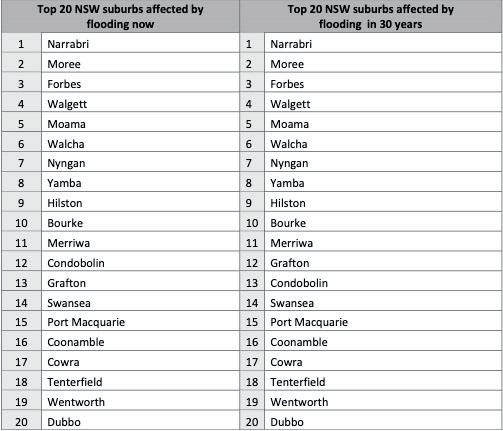
4 minute read
NEW DATA SHOWS HOLIDAY HOTSPOTS AMONG THE NSW LOCATIONS MOST IMPACTED BY FLOODING
Inland towns and tourist hotspots feature highly on the list of the top 20 New South Wales suburbs affected by fooding now, and in the future, according to new data.
In all our lives there are fgures, if not someone that outright looms Mt Everest-like above every granted norm in your feld of interest or expertise, and simply beckons you toward an appreciation of far greater things. That very person for me, is the Bengali writer – Rabindranath Tagore. Little wonder, if not eerily apt then, that his last name even rhymes with the heightened, albeit heightening English word – ‘awe’.
As the frst Asian individual to win the Nobel Prize in Literature (1913), Tagore remains the only person to have ever penned two national anthems and also infuence the actual writing of a third.
The illustrious title of ‘trailblazer’ even seems grossly insuffcient for such a mercurial cultural icon as Tagore, being also the frst Indian to be knighted and in-turn to give the title back, in protest of atrocities committed by the British against his fellow citizens.
No stranger to the truly eclipsing nature of loss, or the far-fung throes and dark cast shadows of personal grief; having suffered the early passing of his wife, beloved sister-in-law and three of his fve children, it is all the more astonishing that Tagore became the supremely selfess and universal writer he did. Or it is perhaps because of such endured and risen above tragedy that he acquired the depth of voice and vision that informs his work, and still resonates to this day. Not often can you say – “I will thank one person” for the abiding passion that you have for anything in particular, but I can, when it comes to the alluring feld that is literature for me, and how it so inherently features, and so utterly frames my world and the absolute wonder I have for it. Many years ago, I remember sitting in the old Sydney City library trying to fnish off a now long forgotten essay, and I happened to glance up at an old faded anthology of an Indian writer that I decided for some unknown reason to just take down from the shelf for a look.
As such, what ensued would become one of the most signifcant happenings, if not turning points of my entire life.
I’ll never forget the impact of the frst passage I read after randomly opening the book: “The little fower lies in the dust. It sought the path of the butterfy.”
What I didn’t know then, but fully appreciate now was how William Butler Yeats got brought to tears in a café after reading Tagore for that frst tantalising time. It is one of those irreversible givens in life, that you can never relive your truly great experiences for the frst time over again. And it is in this spirit that I am envious of anyone who has yet to encounter the artistic gifts and riches of Rabindranath Tagore, for quite simply, if you have not – then what you have in store is a complete and utter revelation, as to what can be done with the awe-inspired aid of words.
Rural Narrabri in the State’s Northwest, comes in at number one for current fooding risk and is also number one on the list of Top 20 NSW suburbs affected by fooding in 30 years, according to data from Groundsure ClimateIndex™ reports, available through InfoTrack.
Rounding out the top fve are Northern New South Wales’ Moree at number two, the Central West’s Forbes at number three, Walgett in the State’s North at number four, and the Riverina’s Moama at fve.
Popular tourist locations also feature – the beautiful coastal town of Yamba, a mecca with holidaymakers, is named at number eight, Grafton in the Northern Rivers comes in at number 13, with bustling Port Macquarie, on the mid north coast, at number 15. The Central Western town of Dubbo sneaks in at number 20 on the list.
Groundsure CEO Dan Montagnani said sophisticated data and modelling is used to assess food risk now and in the future.
“The data and models use high-resolution topographical data, detailed land cover information, and advanced weather on the list of suburbs affected by fooding now, to 12 on the list of suburbs most impacted models to accurately simulate food depths and extents,” Mr Montagnani said.
“This comprehensive evaluation, provided by Royal HaskoningDHV’s division Twinn, encompasses various scenarios, including surface water, river, and tidal fooding, and integrates state-ofthe-art climate models to provide food risk assessments in the context of climate change.”
Interestingly, all the suburbs listed as most at risk now, remain the most at-risk decades from now.
Grafton is slightly more at risk of fooding in the future, going from 13 in 30 years, effectively swapping places with Condobolin.
“The minimal variation between current and future fooding impact rankings can be attributed to the inherent nature of food risk, which is primarily governed by topography. There is very little addition of new high-risk areas,” Mr Montagnani said.
Homebuyers are encouraged to take advantage of the ClimateIndex™ reports which are a new tool, available only to prospective buyers in New South Wales, which analyses data not only on fooding but also bushfres and coastal erosion.
InfoTrack Global Head of Property John Ahern said the Groundsure reports are unique in that they provide propertyspecifc assessments for individual residences, instead of broad regional ratings.
“The reports allow property lawyers and conveyancers to better inform their buyers and that’s more important than ever with fooding an ongoing risk for many regional locations in Australia,” Mr Ahern said.
The list of suburbs worst affected by fooding is tabled below. Prospective homebuyers can search a property address via InfoTrackGO to purchase a Groundsure ClimateIndex™ for that residence.










